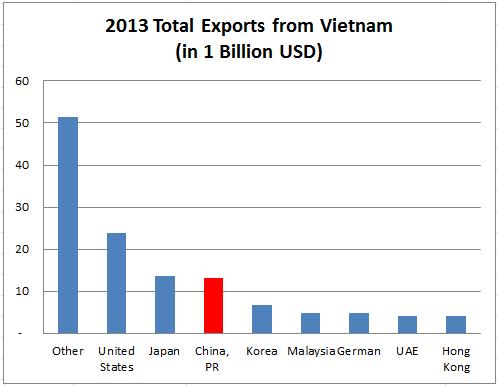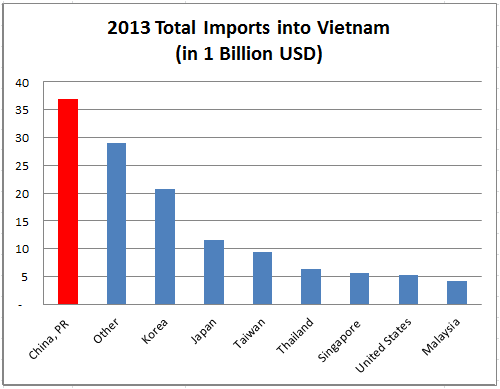China firmly believes it has the dominant hand over Vietnam as they quarrel over the Paracel Islands
On May 1, 2014, one of China’s leading oil and gas companies, CNOOC, deployed its largest oil rig, the HD-981, to the Paracel Islands. The end location was to be stationed in disputed waters, about 120 nautical miles off the coast of Vietnam.
What are the Paracel Islands?
The Paracel Islands are located in the South China Sea and are under territorial dispute by China, Vietnam, and Taiwan. To the Mainland Chinese, the islands are collectively known as Xisha (西沙), whereas to the Vietnamese, they are known as Hoàng Sa.
Like the Spratly Islands, the Paracel Islands are strategically placed in the South China Sea. They are a main sea lane passage point to Northeast Asia and have abundant fisheries around their waters. However, a major factor in the continual dispute is the vast oil and gas resources rumored to be found under the archipelago’s seabed.
The Paracel Islands are only one part of what China deems is rightfully part of their territorial sovereignty within the South China Sea. Other territories under dispute are all located within what the Chinese government calls the “9-Dash Line.”
China is betting that Vietnam has everything to lose
Territorial disputes in the South China Sea are not new. Over the years, countries in the region have vied for sovereignty over a number of islands in order to have exclusive economic control over these waters. However, China’s deployment of CNOOC’s oil rig to the Paracel Islands is uncommon and very provocative.
China has certainly done its homework, and as a result, will be increasing its assertiveness. This situation holds many parallels to Russia’s situation with Crimea. The PRC government is betting that Vietnam is too economically dependent on China, and therefore will treat any Vietnamese threats as empty posturing. China’s calculation depicts Vietnam as having two options: start an all-out war in the name of patriotism and sovereignty, or protest loudly but do nothing.
There are three reasons why the mainland is clearly betting on the latter.
1. China’s increasing influence has backed Vietnam into a corner
Vietnam is isolated internationally and regionally. Vietnam has a communist, authoritarian government whose closest ally has traditionally been China. It has weak ties to the U.S., due to ideological clashes in which the U.S. government backed the opposing Southern Vietnamese government in the nation’s civil war during the 1960s-70s. Vietnam has been warming up to the U.S. in recent years, however, their relationship cannot be compared to neighboring countries like the Philippines, Malaysia, South Korea, and Japan- as evidenced by President’s Obama’s 2014 Asia tour.
In Southeast Asia, Vietnam has little regional support for its territorial disputes with the economic behemoth. This is evidenced by the May 10-11, 2014 ASEAN Semi-Annual Summit in Myanmar, where ASEAN members were unwilling to address Vietnam’s territorial disputes as a collective entity. China is a massive donor and trade partner for the region, and taking China on in such a manner would harm countries like Cambodia, Laos, Singapore, and Thailand who have no territorial stakes within the South China Sea. The incentives do not line up for Vietnam’s neighbors. However, due to these very same factors, China is more than willing to reclaim what they deem is rightfully theirs within the infamous “9-Dash Line.”
2. Taking lessons from Russia, Crimea, and Western non-action
CNOOC’s deployment of their oil rig near the Paracel Islands is timed in the wake of the Crimea crisis, where China has drawn similarities between themselves and Russia. If Western powers did not act in Ukraine, they also will not rush to Vietnam’s side. China has several reasons to expect Western non-action.
First, China has calculated that the U.S. has bigger ties to protecting Ukraine than they do to Vietnam. In 1994, the U.S. signed the Budapest Memorandums promising to protect Ukraine’s territorial sovereignty in exchange for giving up their nuclear weapons. The United States and Vietnam has no security agreements or alliances. If the U.S. did not protect Ukraine’s sovereignty despite having a formal agreement, why would they assist Vietnam?
Second, in the wake of the Crimea crisis, much was said by the U.S. and Europe to denounce Russia but not much action was taken. Sure, U.S. imposed sanctions on Russia’s top seven elite, but there has been little intervention in the aftermath of the Crimea Referendum and Russia’s annexation of the region.
Moreover, the most important factor for China is that the U.S. is tied closer to the Chinese economy than it is to the Russian economy. As seen in the tables below, China is the USA’s number 2 trade partner behind Canada. In comparison, Russia is not even ranked and has only 1% of the U.S.’s trade:
 Source: U.S. Census Bureau
Source: U.S. Census Bureau
Source: U.S. Census Bureau
If the U.S. and the European Union are not intervening in Ukraine, China is certainly betting that there is even less of a probability that they will intervene on Vietnam’s behalf: getting mired in a dispute over some islands on another continent is simply not worth the risk of potentially damaging relationships with a major trading partner.
3. Vietnam’s Economic Dependence on China
China’s growing economy has benefited Vietnam, with the PRC’s share of FDI in Vietnam peaking in 2013 behind South Korea with $US 2.28 billion.
The third and most important reason for China’s surge of confidence in its territorial disputes with Vietnam is the dependency Vietnam has on Chinese Foreign Direct Investment (FDI) and trade.
Historically, foreign investment in Vietnam have been made by countries like South Korea, Japan, and Taiwan. However, with China’s economic growth, growing influence in the region, and energy interests in Southeast Asia– investment in Vietnam has steadily increased. In 2013, China was second to South Korea in investing $US 2.28 billion. This qualifies as 10.2% of Vietnam’s total FDI inflow for the year. This is in stark contrast to previous years, where China invested $0.3 billion and $0.59 billion in 2012 and 2011, respectively.
In regards to trade flows, China tops out Vietnam’s charts in both 2013 imports and exports. For exports, China ranks fourth after the United States, Japan, and all other exporting trade countries with $US 13.26 billion or 10.5% of Vietnam’s total exports for 2013.
Source: General Statistics Department of Vietnam
For imports, China takes the top spot. With Chinese imports coming in with $US 36.95 billion or 28.6% of Vietnam’s total imports for 2013. In total, China makes up 19.6% of Vietnam’s total import and exports for 2013.
Source: General Statistics Department of Vietnam
For Vietnam, this is bad news as the country is still considered a lower middle income country that will require significant trade and investment over the next decade. But with China as a major stakeholder, the Vietnamese government may have to make a difficult choice between patriotism and economic growth.
Outlook
Vietnam’s negotiating stance in the Paracel Island conflict is unfavorable. Vietnam is increasingly dependent on China’s FDI and trade and has few allies internationally and regionally willing to go against the economic giant.
China has hedged its bets by observing Russia’s actions in Crimea. Judging the international response to the Crimea situation, China feels that they can act and raise tensions in the South China Sea with impunity. The United States and Western European powers do not have a stake in Vietnam; count on them to cast critique and judgment, but they will stop far short of sending any military backup to stop China.
What remains to be seen is what happens when China takes the oil rig out of the Paracel Islands on August 28, 2014 to avoid the monsoon season. Will they keep out of the region, or return the very next year and provoke Vietnam again?
Featured image via CNBC




